Bus
A search for love on the No. 94 bus
While visiting Los Angeles from Elk River, Idaho in May 1978, 33-year-old Zan Lawrence met a young woman on the No. 94 bus. They talked for about 20 minutes before she disembarked.Lawrence was smitten, but he didn't know how to contact her. Or even what her name was. So he spent the following weeks riding the same bus back and forth, hoping to meet her again. He also put up signs and placed newspaper ads.
Eventually his search came to the attention of the media, and he was featured in articles. However, the publicity didn't help him locate the young woman. He never did find her again.
Of course, maybe she didn't want to be found.



Los Angeles Times - June 10, 1978

Los Angeles Times - Aug 14, 1978
Posted By: Alex - Mon Sep 02, 2024 -
Comments (1)
Category: 1970s, Bus, Love & Romance
Soviet Bus Stops
Canadian photographer Christopher Herwig has been on a mission to raise awareness of Soviet bus stops. He feels that they're an under-appreciated form of architectural art, "built as quiet acts of creativity against overwhelming state control." But he warns that they're disappearing fast due to demolition.He collected together over 150 of his photographs in the 2015 book Soviet Bus Stops. More recently, a documentary film, again titled Soviet Bus Stops, follows his years-long effort to photograph the bus stops.
More info: Soviet Bus Stops



Posted By: Alex - Fri Jun 14, 2024 -
Comments (2)
Category: Architecture, Mass Transit, Books, Documentaries, Bus
Worst bus service
The following story appeared in The Book of Heroic Failures by Stephen Pile (first published in 1979):Can any bus service rival the fine Haley to Bagnall route in Staffordshire? In 1976 it was reported that the buses no longer stopped for passengers.
This came to light when one of them, Mr. Bill Hancock, complained that buses on the outward journey regularly sailed past queues of up to thirty people.
Councillor Arthur Cholerton then made transport history by stating that if these buses stopped to pick up passengers they would disrupt the time-table.
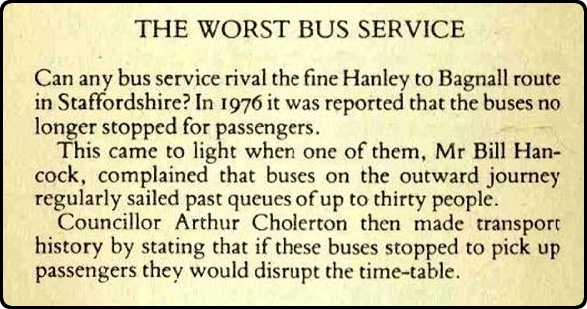
Versions of the story have subsequently appeared in other books, and have circulated online. However, all these other versions seem to rely on Pile's reporting.
And when I searched newspaper archives I couldn't find any confirmation that this incident happened. Which makes me wonder if it really did.
Of course, it might have been reported in a local paper that was never archived online. But some searching around the Internet reveals that I'm not the only one to have wondered if the story might not be true. Check out this comment by "skifans" in the CasualUK subreddit:
This PDF of Staffordshire County Council elections also makes no mention of anyone of that name. A Cholerton stood (and won) a seat in 1973, 1977, 1981 and 1985 - and did not stand in future elections. The seat they stood in for the first to is Stoke On Trent No. 19 (9630), maybe someone knows how to work out where this is but I can't, but for the last 2 it's called Great Fenton - thats in Stoke but not the right area for a route between Hanley and Baghall, on Google maps Great Fenton looks to be just south of the city center and Hanley just to the north, with Bagnall being a small village further to the north east. But the bigger problem, Councillor Cholerton has the first initial F, not A.
There was also an Arthur Cholerton in Stoke, but not as a counciler. Someone with that name was Lord Mayor - but they held the position between 1971 and 1972. (https://en.wikipedia.org/wiki/List_of_lord_mayors_of_Stoke-on-Trent) Alternatively maybe F. Cholerton and Arthur Cholerton are the same person? Between 1981 and 1989 Frederick Arthur Cholerton held the position of chairmen of Staffordshire county council, may they have gone under both names? https://www.staffordshire.gov.uk/Your-council-and-democracy/Civic-and-Ceremonial/The-Chairman-of-the-county-council/Past-Chairmen.aspx
Posted By: Alex - Wed Mar 11, 2020 -
Comments (4)
Category: Mass Transit, 1970s, Bus
Bus Starts
Back in 1985, city officials in St. Louis decided that the term 'bus stop' sounded too negative, so they voted to rename them 'bus starts.' 1800 new 'bus start' signs were duly installed.A year-and-a-half later, when it became clear that people were confused by what a 'bus start' was supposed to be, the city conceded defeat and went back to using the traditional term. This, of course, meant buying even more new signs.
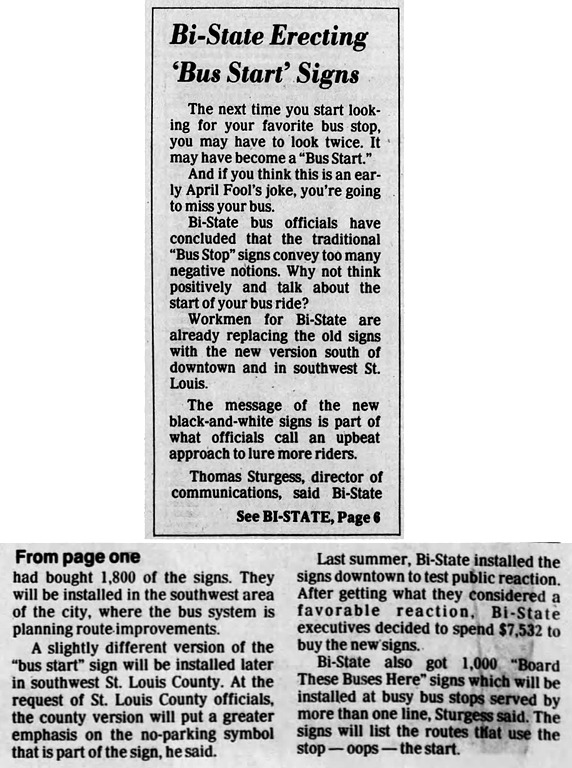
St. Louis Post Dispatch - Mar 28, 1985
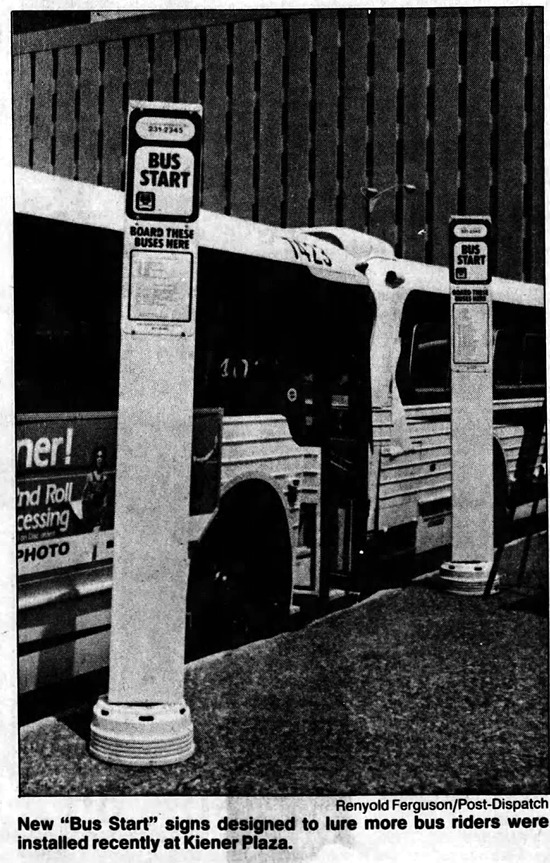
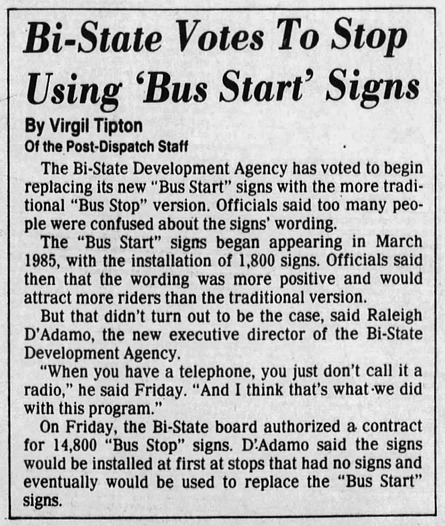
St. Louis Post Dispatch - Aug 24, 1986
Posted By: Alex - Tue Nov 06, 2018 -
Comments (4)
Category: Odd Names, 1980s, Bus
Brazilian bus driver training
In Cariacica, Brazil, part of the bus driver training is to have the drivers ride on a stationary bike while a bus zooms by them at top speed, to give them a sense of how cyclists feel.It seems like with each pass the bus got closer.
via bicycling.com
Posted By: Alex - Thu Oct 25, 2018 -
Comments (3)
Category: Bicycles and Other Human-powered Vehicles, Bus
Bus Road Test
"Bus Tilter" is my new desired job.
Posted By: Paul - Sun May 20, 2018 -
Comments (1)
Category: 1950s, Bus
Follies of the Madmen #366
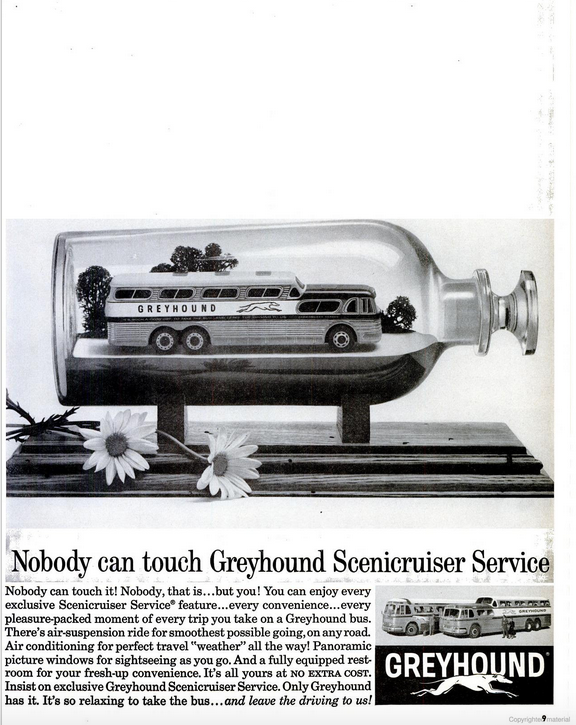
Our service is a dead artifact sealed off from all human contact.
Original ad here.
Posted By: Paul - Fri May 18, 2018 -
Comments (4)
Category: Business, Advertising, 1960s, Bus
An urge to conquer something big
1961: A 14-year-old boy commandeered a Trailways bus and drove it fifteen blocks because he "had an urge to conquer something big" and wanted to drive it "somewhere."Compare this to Bronx bus driver William Cimillo who, in 1947, instead of following his daily route drove the bus to Florida because he was overcome by "that old spring-time urge."
There must be a name for the psychiatric condition of being overcome by a desire to drive a bus to somewhere far away.
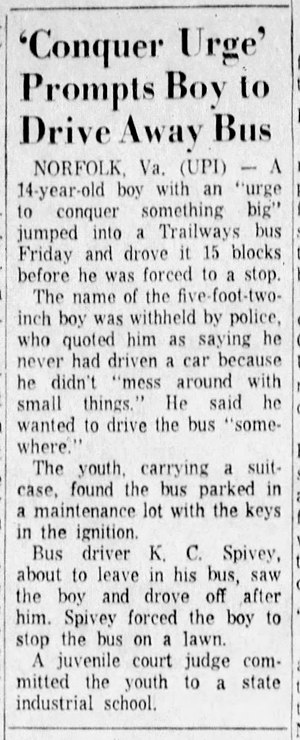
Camden Courier-Post - Sep 2, 1961
Posted By: Alex - Sun Jan 07, 2018 -
Comments (2)
Category: 1960s, Bus
The Love Machine
Created in the late 1960s by Hollywood auto customizer George Barris, who's best known as the designer of the original Batmobile.The Love Machine featured velvet upholstery, a revolving circular bed, psychedelic lights, entertainment console, mirrored ceiling, and a crystal chandelier. It did the rounds at auto shows until the mid-1970s, where it was promoted as the "world's first x-rated car."
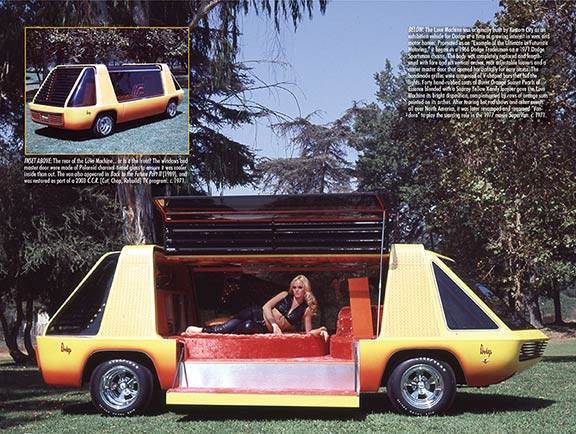
via lastgasp.com

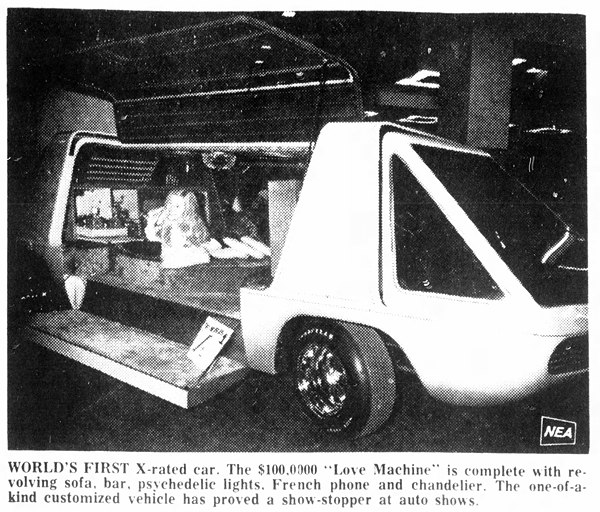
Hillsdale Daily News - Mar 17, 1972
In the late '70s, the Love Machine was rebranded and it went on to have a career in Hollywood. From Hemmings Daily:
Nor would SuperVan be the van’s only screen appearance. It also showed up in the 1986 made-for-TV movie Condor, repainted gold and black; then in 1989’s Back to the Future II as a Hill Valley Transit bus, painted green; in the 1990 movie Solar Crisis, painted white; and then on an episode of the 1990s TV show SeaQuest DSV, still painted white. Then, in about 2003, the Guild of Automotive Restorers began a restoration on the van that brought it back to its Super Van configuration.
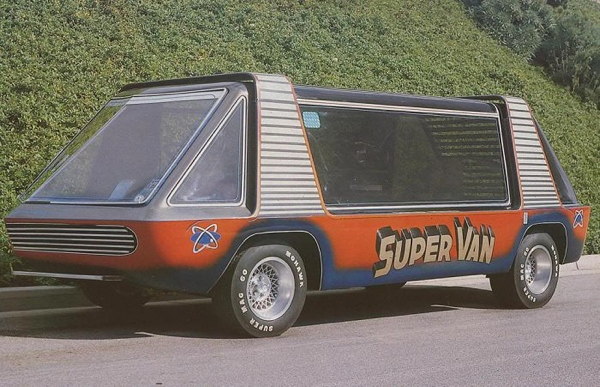
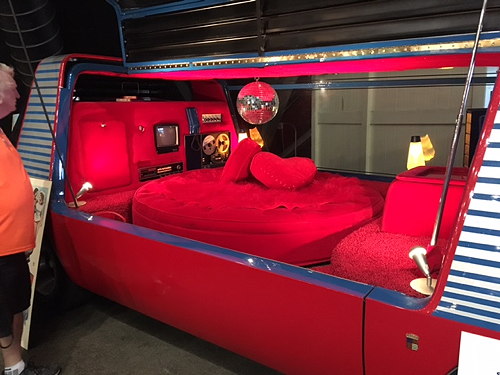
via vanning.com
You can check out more of Barris's creations in the recent book King of the Kustomizers: The Art of George Barris.

Posted By: Alex - Tue Sep 26, 2017 -
Comments (5)
Category: Motor Vehicles, Bus, 1970s
Bus Driver’s Revenge
Today of course he would face federal charges for kidnapping, and many, many lawsuits.Original article here.
See clean transcription below.

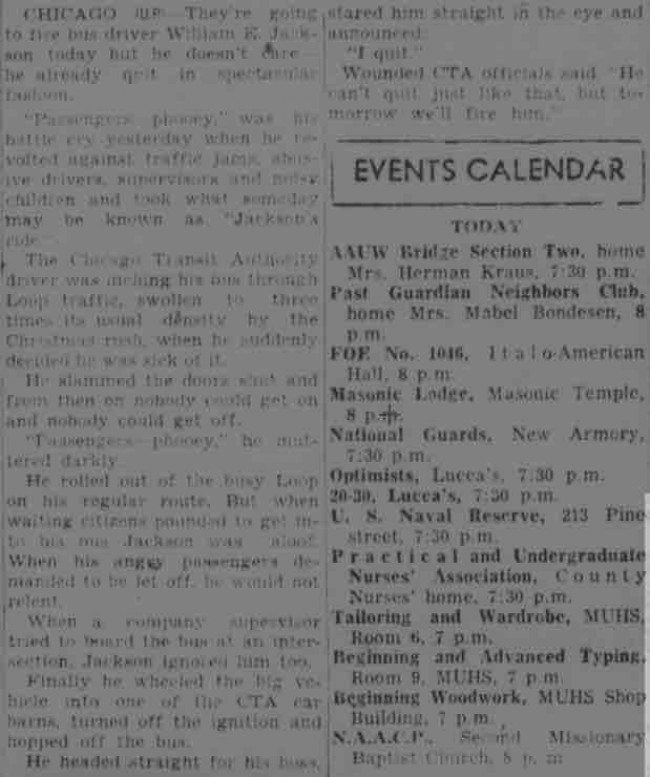
“They’re going to fire bus driver William F. Jackson today but he doesn’t care—he already quit in spectacular fashion.
"Passengers—phooey,” was his battle cry yesterday when he revolted against traffic jams, abusive drivers, supervisors and noisy children and took what someday may be known as “Jacksons’s ride.”
The Chicago Transit Authority driver was inching his bus through Loop traffic, swollen to three times its usual density by the Christmas rush, when he suddenly decided he was sick of it.
He slammed the doors shut and from then on nobody could get off.
“Passengers—phooey,” he muttered darkly.
He rolled out of the busy Loop on his regular route. But when waiting citizens pounded to get into his bus Jackson was aloof. When his angry passengers demanded to be let off he would not relent.
When a company supervisor tried to board the bus at an intersection Jackson ignored him too.
Finally he wheeled the big vehicle into one of the CTA barns, turned off the ignition, and hopped off the bus.
He headed straight for his boss, stared him straight in the eye and announced:
“I quit.”
Wounded CTA officials said, “He can’t quit just like that, but tomorrow we’ll fire him.”
Posted By: Paul - Tue Jan 12, 2016 -
Comments (8)
Category: Annoying Things, Jobs and Occupations, 1950s, Bus, Nausea, Revulsion and Disgust

| Who We Are |
|---|
| Alex Boese Alex is the creator and curator of the Museum of Hoaxes. He's also the author of various weird, non-fiction, science-themed books such as Elephants on Acid and Psychedelic Apes. Paul Di Filippo Paul has been paid to put weird ideas into fictional form for over thirty years, in his career as a noted science fiction writer. He has recently begun blogging on many curious topics with three fellow writers at The Inferior 4+1. Contact Us |




